|
|
Saving A Wounded Lioness
|
The lion has been an icon for humanity for thousands of years, appearing in cultures across Europe, Asia, and Africa. Despite incidents of attacks on humans, lions have enjoyed a positive depiction in culture as strong but noble. A common depiction is their representation as "king of the jungle" or "king of beasts"; hence, the lion has been a popular symbol of royalty and stateliness, as well as a symbol of bravery; it is featured in several fables of the sixth century BC Greek storyteller Aesop.
Representations of lions date back 32,000 years; the lion-headed ivory carving from Vogelherd cave in the Swabian Alb in southwestern Germany has been determined to be about 32,000 years old from the Aurignacian culture. Two lions were depicted mating in the Chamber of Felines in 15,000-year-old Paleolithic cave paintings in the Lascaux caves. Cave lions are also depicted in the Chauvet Cave, discovered in 1994; this has been dated at 32,000 years of age, though it may be of similar or younger age to Lascaux.
Ancient Egypt venerated the lioness (the fierce hunter) as their war deities and among those in the Egyptian pantheon are, Bast, Mafdet, Menhit, Pakhet, Sekhmet, Tefnut, and the Sphinx; The Nemean lion was symbolic in Ancient Greece and Rome, represented as the constellation and zodiac sign Leo, and described in mythology, where its skin was borne by the hero Heracles. The lion was a prominent symbol in ancient Mesopotamia (from Sumer up to Assyrian and Babylonian times), where it was strongly associated with kingship. The classic Babylonian lion motif, found as a statue, carved or painted on walls, is often referred to as the striding lion of Babylon. It is in Babylon that the biblical Daniel is said to have been delivered from the lion's den.
In the Puranic texts of Hinduism, Narasimha ("man-lion") a half-lion, half-man incarnation or (avatara) of Vishnu, is worshipped by his devotees and saved the child devotee Prahlada from his father, the evil demon king Hiranyakashipu; Vishnu takes the form of half-man/half-lion, in Narasimha, having a human torso and lower body, but with a lion-like face and claws. Singh is an ancient Indian vedic name meaning "lion" (Asiatic lion), dating back over 2000 years to ancient India. It was originally only used by Rajputs a Hindu Kshatriya or military caste in India. After the birth of the Khalsa brotherhood in 1699, the Sikhs also adopted the name "Singh" due to the wishes of Guru Gobind Singh. Along with millions of Hindu Rajputs today, it is also used by over 20 million Sikhs worldwide. Found famously on numerous flags and coats of arms all across Asia and Europe, the Asiatic lions also stand firm on the National Emblem of India. Further south on the Indian subcontinent, the Asiatic lion is symbolic for the Sinhalese, Sri Lanka's ethnic majority; the term derived from the Indo-Aryan Sinhala, meaning the "lion people" or "people with lion blood", while a sword wielding lion is the central figure on the national flag of Sri Lanka.
|
|









